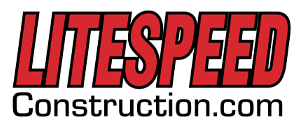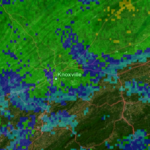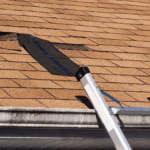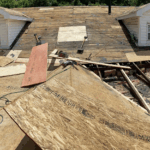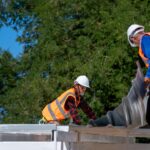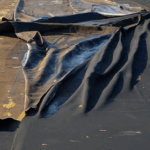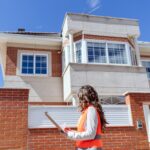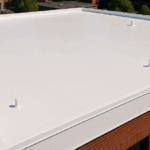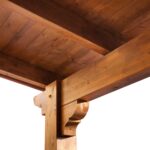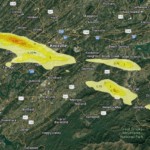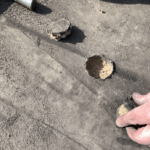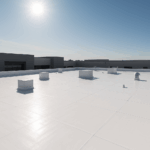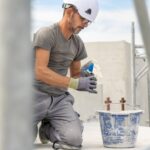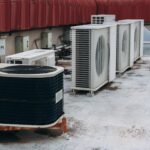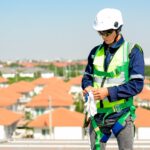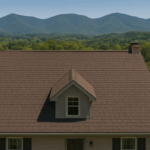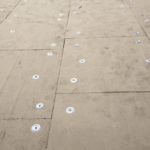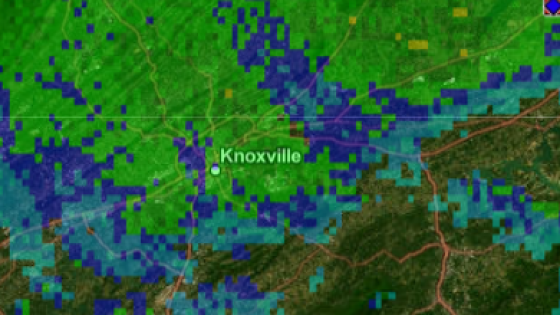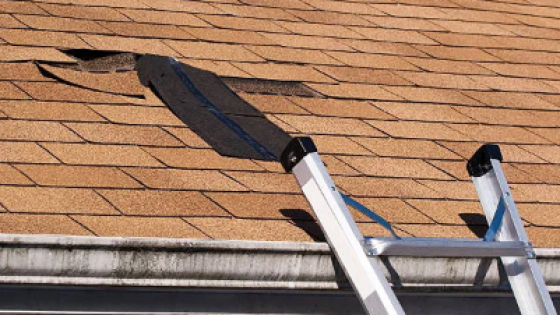Knoxville, TN, sits in the humid subtropical climate zone, experiencing an average of 50.3 inches of rainfall annually (NOAA). This high moisture load, combined with frequent thunderstorms and temperature swings of 30°F or more in a single day, puts enormous stress on commercial roofing systems.
Commercial roof moisture intrusion happens when water penetrates the roof’s protective layers and becomes trapped in the insulation or structural deck. In our region, this issue is accelerated by seasonal storms, heavy humidity, and even pollen buildup that clogs drainage systems.
Once water is inside your roof assembly, it doesn’t just cause visible leaks — it silently reduces insulation effectiveness, corrodes steel decking, and fosters mold growth. According to the U.S. Department of Energy, wet insulation can lose up to 75% of its thermal resistance.
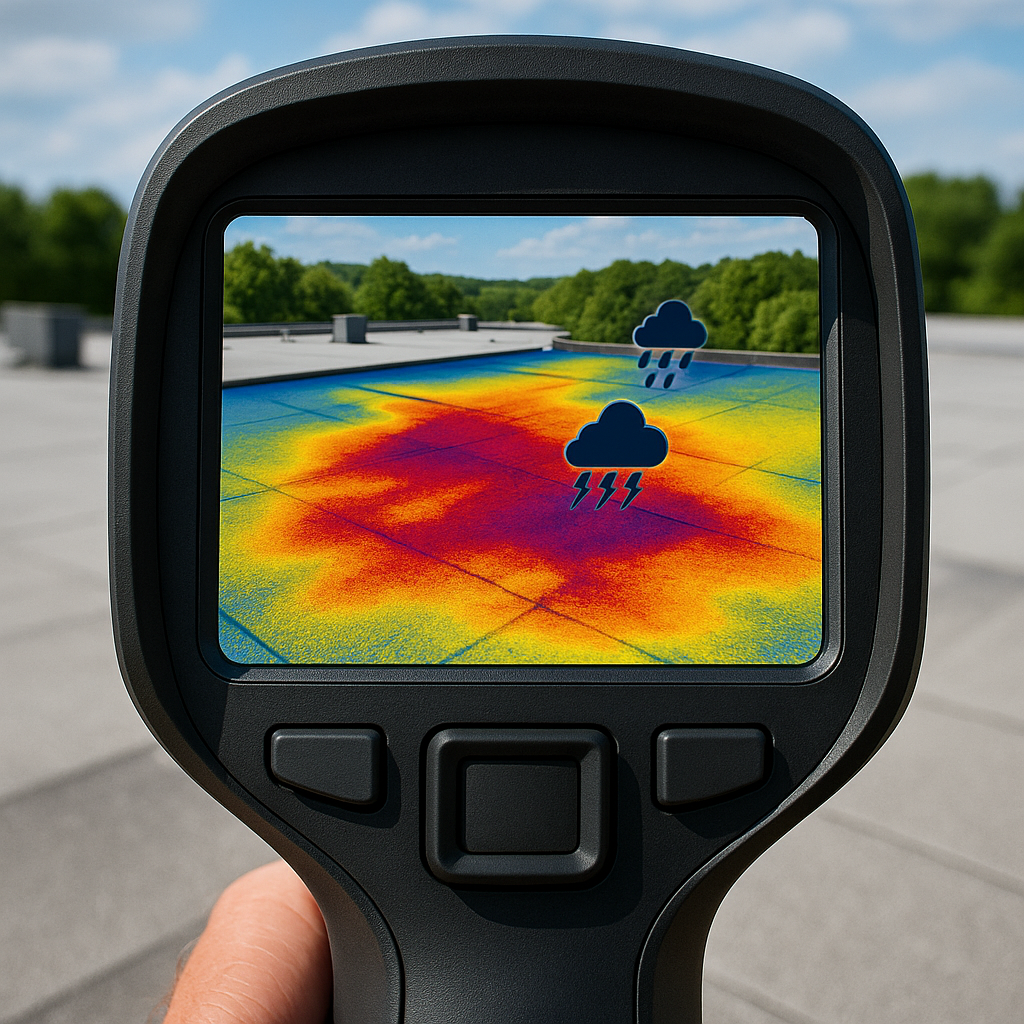
For Knoxville building owners, this means higher HVAC bills, faster roof degradation, and potential OSHA violations if leaks create workplace hazards. Partnering with a Knoxville roofing contractor like Litespeed Construction ensures early detection using advanced diagnostics that can save thousands in repairs.
Key Takeaways
💡Early detection = major savings
💡Knoxville’s climate is high-risk
💡Dry insulation keeps HVAC costs down by 15–30%
💡Professional tools are essential
Knoxville-Specific Moisture Intrusion Risk Profile
| Factor | Knoxville Data | Impact on Roofs |
|---|---|---|
| Average Annual Rainfall | 50.3 in (NOAA) | Higher chance of water ponding & infiltration |
| Average Humidity | 70%+ year-round | Encourages mold & mildew growth |
| Average Summer Temperature Highs | 88°F | Thermal expansion stresses seams |
| Winter Freezing Days | 60+ per year | Freeze-thaw cycles crack membranes |
| Severe Weather Events | 15–20 annually | Hail & wind damage compromise waterproofing |
Warning Signs of Commercial Roof Moisture in Knoxville Buildings
While some symptoms are obvious, others are invisible without specialized tools.
| Visible Sign | Possible Cause | Knoxville Example |
|---|---|---|
| Membrane blistering | Moisture expanding under solar heat | Flat EPDM roof near downtown showing summer bubbles |
| Stained ceiling tiles | Water migrating through decking | West Knoxville retail space after summer storms |
| Mold smell indoors | Moisture trapped in insulation | Riverfront office building post-flood |
| Energy bill spike | Wet insulation losing R-value | Industrial warehouse in East Knoxville |
| Soft spots when walked on | Rotting decking | School gym roof post-hailstorm |
Professional Detection Methods
1. Infrared Thermography
How It Works: Infrared cameras detect subtle temperature variations across the roof surface. Wet insulation holds heat differently than dry insulation, creating a thermal signature.
- Best Use Case in Knoxville: Warm, dry evenings after sunny days, especially in summer.
Government Reference: U.S. DOE – Building Envelope Diagnostics
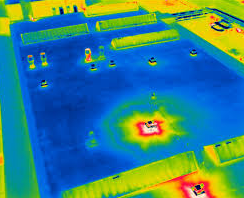
2. Electronic Leak Detection (ELD)
How It Works: Electrical currents trace paths through breaches in the membrane.
- Best Use Case in Knoxville: Ideal after hailstorms, when punctures are common.
Industry Standard: ASTM D7877 — Standard Guide for Electronic Methods for Detecting and Locating Leaks in Waterproof Membranes.
3. Moisture Meters
Handheld tools that measure moisture content of roofing materials.
Benefit: Pinpoints saturation depth and severity.
4. Core Sampling
Physically removing a section of the roof to measure insulation moisture content.
Drawback: Slightly invasive but highly accurate.
Financial and Energy Impacts
| Impact Area | Without Detection | With Detection |
|---|---|---|
| Annual Energy Costs | +20–30% due to lost insulation R-value | Savings of $0.25–$0.50 per sq. ft. annually |
| Roof Lifespan | Reduced by up to 50% | Extended by 10–15 years |
| Replacement Costs | $8–$15 per sq. ft. sooner than expected | Deferred 10+ years |
| Property Value | Decrease due to poor condition report | Maintained or increased |
Reference: National Roofing Contractors Association
Knoxville Building Code & Moisture Management
Per the 2018 International Building Code (IBC) adopted in Tennessee:
- Roofing materials must be installed to prevent water infiltration (§1503).
- Damaged insulation or membranes must be replaced when moisture-damaged (§1510).
Failure to comply can result in fines or insurance claim denials.
Environmental Impact
Knoxville’s Contribution to Heat Island Effect:
- Downtown Knoxville temperatures average 1–3°F hotter than surrounding rural areas due to dense roofing surfaces.
- Moisture-free, reflective roofs help lower surface temperatures and reduce cooling demand.
Carbon Savings:
Replacing wet insulation can reduce building CO₂ emissions by 0.5–1.5 metric tons annually per 10,000 sq. ft.
Case Studies
Case Study 1: Knoxville Office Complex
- Building Size: 40,000 sq. ft.
- Issue: Energy bills increased by 18% over 6 months.
- Findings: Infrared scan revealed 6,200 sq. ft. of wet insulation.
- Action: Replaced wet sections, sealed seams.
- Result: $8,500 annual energy savings, roof life extended 12 years.
Case Study 2: West Knoxville Retail Center
- Issue: Visible ceiling stains in 3 stores.
- Findings: Electronic leak detection located 4 punctures from hail damage.
- Action: Targeted repairs with membrane patches.
- Result: Stopped leaks without full roof replacement.
Recommended Moisture Detection Schedule for Knoxville Businesses
| Building Type | Inspection Frequency | Reason |
|---|---|---|
| Office / Retail | Annually + post-storm | Prevent interior damage to tenants |
| Industrial / Warehouse | Biannually + post-storm | Protect stored goods & equipment |
| Schools / Government | Biannually | Safety compliance |
| Healthcare Facilities | Quarterly | Maintain sterile environments |
Pros and Cons of Moisture Detection
| Pros | Cons |
|---|---|
| Prevents costly premature replacements | Upfront inspection costs |
| Boosts energy efficiency | Weather-dependent testing times |
| Improves indoor air quality | Some methods are invasive |
| Enhances resale value | Requires professional expertise |
| Supports code compliance & insurance claims | — |
Knoxville Business Owner Action Plan
- Schedule an infrared scan after major storms.
- Review inspection reports with a licensed Knoxville roofing contractor.
- Repair damaged areas immediately to stop moisture spread.
- Document repairs for insurance and future buyers.
FAQs about Commercial Roof Moisture Intrusion
Yes — high year-round humidity accelerates mold growth and material degradation.
Yes — warranties often require documented inspections to remain valid.
Infrared thermography combined with core sampling.
No — once insulation is saturated, replacement is necessary.
Yes — we deliver detailed, photo-documented moisture maps for each project.
Within weeks to prevent spread and further damage.
Flat or low-slope roofs with single-ply membranes.
Clear debris, ensure safe access, and schedule in dry weather.
No — most methods are non-invasive and done outside business hours.
Contact Litespeed Construction for a free consultation and site assessment.
Conclusion
Knoxville’s climate makes commercial roof moisture intrusion a very real and costly risk — but one that’s entirely preventable with proactive inspections. With advanced diagnostic tools, code-compliant repairs, and decades of local expertise, Litespeed Construction helps businesses save money, extend roof life, and protect their investments.
Call us today to schedule a moisture detection assessment and keep your building dry, safe, and energy-efficient.
